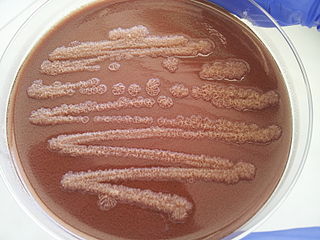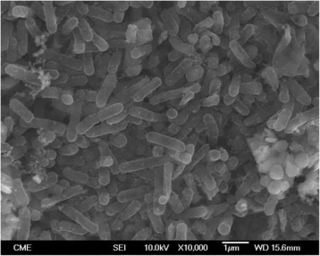
The phylum Bacteroidota is composed of three large classes of Gram-negative, nonsporeforming, anaerobic or aerobic, and rod-shaped bacteria that are widely distributed in the environment, including in soil, sediments, and sea water, as well as in the guts and on the skin of animals.

Acidobacteriota is a phylum of Gram-negative bacteria. Its members are physiologically diverse and ubiquitous, especially in soils, but are under-represented in culture.
The Thermomicrobia is a group of thermophilic green non-sulfur bacteria. Based on species Thermomicrobium roseum and Sphaerobacter thermophilus, this bacteria class has the following description:

Pseudomonas aeruginosa is a common encapsulated, gram-negative, aerobic–facultatively anaerobic, rod-shaped bacterium that can cause disease in plants and animals, including humans. A species of considerable medical importance, P. aeruginosa is a multidrug resistant pathogen recognized for its ubiquity, its intrinsically advanced antibiotic resistance mechanisms, and its association with serious illnesses – hospital-acquired infections such as ventilator-associated pneumonia and various sepsis syndromes.

Pseudomonas stutzeri is a Gram-negative soil bacterium that is motile, has a single polar flagellum, and is classified as bacillus, or rod-shaped. While this bacterium was first isolated from human spinal fluid, it has since been found in many different environments due to its various characteristics and metabolic capabilities. P. stutzeri is an opportunistic pathogen in clinical settings, although infections are rare. Based on 16S rRNA analysis, this bacterium has been placed in the P. stutzeri group, to which it lends its name.
Chloracidobacterium is a genus of the Acidobacteriota. It is currently assigned to the family Acidobacteriaceae, but phylogenetic evidence suggests that it belongs in Blastocatellia.

Latilactobacillus sakei is the type species of the genus Latilactobacillus that was previously classified in the genus Lactobacillus. It is homofermentative; hexoses are metabolized via glycolysis to lactic acid as main metabolite; pentoses are fermented via the Phosphoketolase pathway to lactic and acetic acids.
Alteromonas macleodii is a species of widespread marine bacterium found in surface waters across temperate and tropical regions. First discovered in a survey of aerobic bacteria in 1972, A. macleodii has since been placed within the phylum Pseudomonadota and is recognised as a prominent component of surface waters between 0 and 50 metres. Alteromonas macleodii has a single circular DNA chromosome of 4.6 million base pairs. Variable regions in the genome of A. macleodii confer functional diversity to closely related strains and facilitate different lifestyles and strategies. Certain A. macleodii strains are currently being explored for their industrial uses, including in cosmetics, bioethanol production and rare earth mining.
Acidobacterium capsulatum is a bacterium. It is an acidophilic chemoorganotrophic bacterium containing menaquinone. It is gram-negative, facultative anaerobic, mesophilic, non-spore-forming, capsulated, saccharolytic and rod-shaped. It is also motile by peritrichous flagella. Its type strain is JCM 7670.

Acidithiobacillus thiooxidans, formerly known as Thiobacillus thiooxidans until its reclassification into the newly designated genus Acidithiobacillus of the Acidithiobacillia subclass of Pseudomonadota, is a Gram-negative, rod-shaped bacterium that uses sulfur as its primary energy source. It is mesophilic, with a temperature optimum of 28 °C. This bacterium is commonly found in soil, sewer pipes, and cave biofilms called snottites. A. thiooxidans is used in the mining technique known as bioleaching, where metals are extracted from their ores through the action of microbes.
Rhodoferax is a genus of Betaproteobacteria belonging to the purple nonsulfur bacteria. Originally, Rhodoferax species were included in the genus Rhodocyclus as the Rhodocyclus gelatinous-like group. The genus Rhodoferax was first proposed in 1991 to accommodate the taxonomic and phylogenetic discrepancies arising from its inclusion in the genus Rhodocyclus. Rhodoferax currently comprises four described species: R. fermentans, R. antarcticus, R. ferrireducens, and R. saidenbachensis. R. ferrireducens, lacks the typical phototrophic character common to two other Rhodoferax species. This difference has led researchers to propose the creation of a new genus, Albidoferax, to accommodate this divergent species. The genus name was later corrected to Albidiferax. Based on geno- and phenotypical characteristics, A. ferrireducens was reclassified in the genus Rhodoferax in 2014. R. saidenbachensis, a second non-phototrophic species of the genus Rhodoferax was described by Kaden et al. in 2014.
Bryocella elongata is a bacterium, a type species of genus Bryocella. Cells are Gram-negative, non-motile pink-pigmented rods that multiply by normal cell division and form rosettes. The type strain is SN10(T). B. elongata was first isolated in 2011 from a methanotropic enrichment culture.
Deinococcus marmoris is a Gram-positive bacterium isolated from Antarctica. As a species of the genus Deinococcus, the bacterium is UV-tolerant and able to withstand low temperatures.
Symbiobacterium thermophilum is a symbiotic thermophile that depends on co-culture with a Bacillus strain for growth. It is Gram-negative and tryptophanase-positive, with type strain T(T). It is the type species of its genus. Symbiobacterium is related to the Gram-positive Bacillota and Actinomycetota, but belongs to a lineage that is distinct from both.S. thermophilum has a bacillus shaped cell structure with no flagella. This bacterium is located throughout the environment in soils and fertilizers.
Congregibacter litoralis KT71 is a gram-negative Gammaproteobacteria part of the NOR5/OM60 Clade discovered in seawater from Heligoland, an island in the North Sea by H. Eilers from the Max Planck Institute for Microbiology. C. litoralis KT71 is described as a pleomorphic bacterium and has a size of 2 x 0.5 μm. When grown in culture, C. litoralis KT71 has a generation time of 4.5 hours and prefers to grow on complex substrates where the sole carbon source is undefined, though it can utilize some sole carbon sources because they are most likely used by the organism for its central metabolism.
Koribacter versatilis is a member of the Acidobacteriota phylum which itself is a newly devised phylum of bacteria, and is only distantly related to other organisms in the domain bacteria. Its closest phylogenetic relative is "Candidatus Solibacter usitatus", according to Michael Nerdahl. It contains 5,650,368 nucleotides, 4,777 proteins, and 55 RNA genes, and has a circular chromosome according to information found from GenBank. According to the Joint Genome Institute, “The bacterium is a gram-negative, highly capsulated, aerobic heterotroph that grows with a range of sugars, sugar polymers, and some organic acids.”
Dokdonia donghaensis is a strictly aerobic, gram-negative, phototrophic bacterium that thrives in marine environments. The organism can grow at a broad range of temperatures on seawater media. It has the ability to form biofilms, which increases the organism's resistance to antimicrobial agents, such as tetracycline.
Dokdonia is a genus of bacteria in the family Flavobacteriaceae and phylum Bacteroidota.
Cytophagales is an order of non-spore forming, rod-shaped, Gram-negative bacteria that move through a gliding or flexing motion. These chemoorganotrophs are important remineralizers of organic materials into micronutrients. They are widely dispersed in the environment, found in ecosystems including soil, freshwater, seawater and sea ice. Cytophagales is included in the Bacteroidota phylum.
The Holophagae is a class of Acidobacteriota.
1. Eichorst, Stephanie A., John A. Breznak, and Thomas M. Schmidt. "Isolation and Characterization of Soil Bacteria That Define Terriglobus Gen. Nov., in the Phylum Acidobacteria." Applied and Environmental Microbiology. American Society for Microbiology, 15 Apr. 2007. Web. 11 Dec. 2018.
2.^ Suman R. Rawat, Minna K. Männistö, Valentin Starovoytov, Lynne Goodwin, Matt Nolan, Lauren Hauser, Miriam Land, Karen Walston Davenport, Tanja Woyke, and Max M. Häggblom. "Complete Genome Sequence of Terriglobus saanensis Type Strain SP1PR4 T , an Acidobacteria from Tundra Soil." Standards in Genomic Sciences. BioMed Central, 10 Oct. 2012. Web. 11 Dec. 2018.
3. Singer, Esther, Bill Andreopoulos, Robert M. Bowers, Janey Lee, Shweta Deshpande, Jennifer Chiniquy, Doina Ciobanu, Hans-Peter Klenk, Matthew Zane, Christopher Daum, Alicia Clum, Jan-Fang Cheng, Alex Copeland, and Tanja Woyke. "Next Generation Sequencing Data of a Defined Microbial Mock Community." Nature News. Nature Publishing Group, 27 Sept. 2016. Web. 11 Dec. 2018.
4. Klappenbach, J. A., J. M. Dunbar, and T. M. Schmidt. 2000. rRNA operon copy number reflects ecological strategies of bacteria. Appl. Environ. Mi- crobiol. 66:1328–1333.






